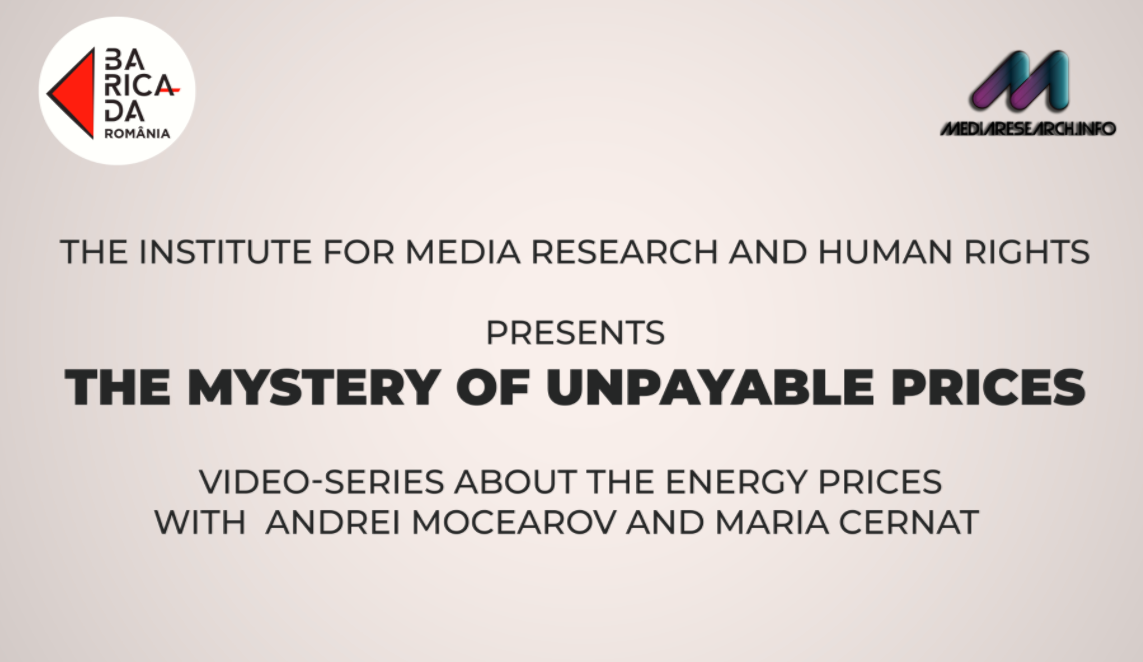Energy Markets – Misinformation and Expectations
To understand why energy prices are rising, we need to understand how energy markets work and, in particular, what energy spot markets mean. The Institute for Media Research and Human Rights in partnership with the Baricada website offer an in-depth discussion of these issues. In the first part we looked at how the natural monopoly has moved to energy markets. Now it’s time to understand why spot markets are extremely volatile and susceptible to misinformation. Here, Andrei Mocearov, a graduate of the Faculty of Energetics and the Academy of Economic Studies, will explain more about how even European officials contributed to the artificial price increases. Professor Andrei Mocearov has worked in the Chamber of Deputies as a parliamentary civil servant, holding successively several senior positions: Head of the Secretariat of the Committee on European Affairs, Director of the Directorate for EU Law and Head of the Department for Parliamentary Studies and EU Policies. From 2013 to 2017 he was the correspondent of the Chamber of Deputies at the European Centre for Parliamentary Research and Documentation (ECPRD). We invite you to join us to see how panic-inducing claims led to significant increases in energy prices before Russia’s invasion of Ukraine began.
Video (in Romanian; translation of transcript to follow):
Maria:
And so on to the next chapter. What does the spot market mean? You’re on the energy market and then we’ll move on to the spot markets. I’m very curious to find out how it works. I can’t imagine how you trade energy? Anyway, I have a simplistic view. I’m a humanist. I don’t have much connection to economics. And then I can easily imagine a real goods market. I can even imagine a credit market, a capital market. I find this energy thing a bit science fiction and I find it very hard to understand.
Andrei:
There are four energy markets. I put them here. The gas market. Electricity market. We know them. It’s the carbon market, and it’s relatively well known this trading scheme, which is a purely financial market. Finally, there’s the derivatives market. That’s what almost nobody knows about. I mean the gas market and the electricity market are markets where electricity and gas are considered commodities, because they are markets, especially in gas, global. The carbon market is a purely financial market, but it’s the same with this derivatives market. It is recognised as such as an energy market, i.e. a purely financial derivative. An energy product, i.e. the same way electricity enters your home. This financial instrument does not enter anyone’s home. It is only in the casino, above the physical system. This derivative is considered electricity. These derivative instruments are financial instruments attached to energy and gas instruments. They are originally made to protect real transactions from price fluctuations, so-called “hedges,” “hedge instruments.” The French, however, have called these instruments “speculative instruments”. Of course this good intention to protect has been turned into a terrible speculation.
I will come back in the course of my presentation, in detail, to how these financial markets work in relation to the energy markets. And there are three circuits of the gas and electricity markets – physical, commercial and financial – which are somewhat related to the markets I have described. How?
The physical circuit. That involves the movement of electricity and gas coming into our homes. It starts from the producer, it is transported and finally reaches the end consumer. It’s the commercial circuit where they’re shared like in the market. It’s normal, payments are made. Of course physical goods are traded, that’s important. There is the financial circuit where only financial goods are traded. But that’s attached to the physical commodity. I mean, in fact, there’s a paper, a promise that they sell gas, but there’s no gas or electricity moving behind it, just paper. Which they are, like stocks, bonds.
Maria:
Now I’m beginning to understand, but it’s hard.
Andrei:
I admit it’s hard because it’s abnormal. I mean what’s the point of these financial products? I remember I was talking to one of my friends, intelligent and very educated, who asked me because I wrote on Facebook that it’s a financial casino built on the national energy system. And he asked me what that meant. Very few people imagine that beyond this technical engineering work of producing, transmitting and distributing electricity and gas, there are some who have created a financial casino for fun. There’s a play that was launched by David Schwartz.
Maria:
Yes, yes.
Andrei:
The energy is one of skits. It explains very well how these markets work. Now, how the gas market works.
Historically, there have been three separate markets: North America, Europe, Asia, and prices were determined in each market. The price of gas was linked to the price of oil. So there were long-term contracts. For example, the Russians had contracts with Germany for 10, 15 and even 20 years. These long-term contracts were linked to the price of oil. But the linking to the price of oil was done with delays, that is, if there was a very large increase or, on the contrary, a very large decrease in the price of oil over a short period of time. They were not taken up in long-term gas contracts. So this correction was made after six months. Those who had the gas contracts were looking to see if the market had really stabilized at a higher price or was it just short-term volatility. Of course pipeline gas was prevailing.
Today the growth of unconventional energy sources has grown first. There’s a very big discussion here, which is actually geopolitical. America has decided to evolve independently and, thanks to technological advances, to exploit shale gas. It’s a very big discussion. My opinion is that it was speculation, because these shale gasses are not efficient. But being worth a lot of money, they invested money there and gave the impression that they are efficient. But they served to keep prices down.
This is a typical scheme in capitalism, where a big state or a big company can produce at a loss, in fact for many years at very low prices to corner the market. And what happened immediately was certainly the increase in long-distance transport. That is to say, this gas was shut off, liquefied and then converted back into gas. But to do that, the gas had to be transported across the ocean. What is more important here is that the link between the price of gas and the price of oil has been removed. That is to say, America’s geopolitical option, first and foremost, was to create a global gas market and grow. Of course, increasing the share of transactions in the market, which means the spot market, means very short-term transactions. There are transactions almost every 15 minutes.
Maria:
Wait a minute, where are they being done? In a casino?
Andrei:
They do it somewhere on a stock exchange, on a computer. There are traders there bidding just like on the exchange.
Maria:
Who are bidding just like on Wall Street.
Andrei:
You see, they’re splitting up these hubs. Each exchange is a hub where the gas is distributed from there. I mean you put the gas on that hub. Yeah, that’s an operation beyond the physical movement of the gas. It’s actually a fictitious operation, I mean virtual, without necessarily having a physical movement of gas behind it. Right at this commercial circuit. I mean you can sell gas and then buy it back. I mean you buy it back, come and buy it, I mean you do some transactions. And, by the way, anybody who watches this stuff knows that the number of transactions that are done is much higher than the number of actual, physical gas or electricity transactions.
Here’s a map taken from Le Monde Diplomatique, where it shows what was happening in 2020. In fact, before the crisis that we have and before the war in the first place. And here you can see this one with purple is the gas coming from Russia to Europe and another one is from Norway. Liquefied it is. The gas goes from America to Asia mostly and also comes a little bit to Europe. And here the Middle East, again Australia supplies Asia. What’s important in this scheme? That the European Union, I mean Europe, was primarily classically supplied, I mean it was out of fashion, it was in a geopolitical gap, it was sitting on pipelines and cheap gas, long contracts. A shame, isn’t it?
But America was increasingly worried. What are we going to do? Germany has cheap, safe gas. And here you can see, it’s actually a report and some scenarios, but you can see that since 2010 GEO has increased its share a lot. Here is a project, which is under construction. And here are three scenarios. How much is needed in the future.
Now we come to the really key point in my presentation. How do spot markets work? So on the one hand, of course there are the economic fundamentals of physical supply and demand, of electricity and gas. If production goes down, if demand goes up and so on. Prices are generated in a normal market. The law of supply and demand is seen in the logical economics textbook. But there is a key word “expectations”. Which economists use and are scared of in a way, because because of expectations they make many errors in forecasts. They say economists fail in forecasting. They know how to explain what happened, why it happened, what happened, but less to predict what will happen. And one of the reasons is that expectations are created by emotions. Which can be natural or premeditated misinformation. In general, there’s shock if a comet is observed to hit the Earth, it’s certainly a terrible shock. But that’s real, you can see it. There are some scientists who say, “Oh, my God, the comet is coming and hitting us. Yes, a made-up comet is coming. Then somebody could say, oh, my God, here comes the comet, which isn’t actually coming, it was a movie, right?
Maria:
Yes, exactly. Exactly. I was going to say here that it’s very interesting that there’s no regulation in this area of journalism. I wrote an article about the ethics of financial journalism. At one point they caught two journalists doing what? They were friends and one of them, at one point, was writing very badly about a company. The stock was going down: my friends, don’t buy stock. Then he starts praising the company. So that’s exactly what the premeditated misinformation was going on, when he was praising the company. The stock would go up, the friend would sell the stock, of course, make a profit, split that profit and the money. I mean, when there’s very high volatility and there’s no serious regulation and people are not responsible with what they write and what they speak, it’s extraordinarily easy to produce such emotions and to produce basically, how shall I say, very big discrepancies between what you say and what you write, right?
Andrei:
Of course. And now you can see why the important spot markets in long-term contracts couldn’t create these situations, or it would be very hard. I stress that long-term contracts were linked to the price of oil, but an emotion created there was not automatically picked up if it was with a delay. And further. I have titled here a bunch of slides “misinformation and expectations”, i.e., my view that we have and are dealing with a media crisis. So not a crisis of physical energy. And even if, especially after the war in Ukraine, Russia’s invasion of Ukraine, there was also a physical energy issue. We will see further on. However, even if there were, it probably exists. To a certain extent, it is impossible to explain why prices are rising 10-15 times. I mean you can say it went up 10-15 percent, but not unpayable prices. No, I can’t. Normal markets can’t produce prices that freeze everything.
Maria:
Right. So, I explained that we’re very much interested in misinformation and expectations. You’re basically referring to public reaction.
Andrei:
Yes, to the public reaction and especially to the reaction primarily of the players, the players in the energy markets. I gave an example, so already in the autumn of 2021 they appeared before the war in Ukraine. Prices started to rise after the summer of 2021. In September, they took off. And all kinds of statements appeared at the political level. For example, Fatih Birol, he’s the head of the International Energy Agency, created from the OECD. It’s a neoliberal think tank. You didn’t know that little detail. I mean there’s a neoliberal think tank.
Maria:
Yes, yes, which seem so… progressive.
Andrei:
Neoliberalism does not mean privatization, deregulation, competition, or stability. Someone, a friend of mine from Canada, asked me but we don’t use that set of values. And I referred her to a Krugman article because Krugman speaks in the same tone.
What Fatih Birol says is the following. He says we believe, we put exactly from English, where they are taken from. He gave an interview in the Financial Times at the time and he says that there are elements, strong indications that there is a very strong contraction in the gas market, I mean in the sense that demand has increased and supply has decreased and this and this is because of Russia’s behavior. So, he says, whatever, the current shortfall in storage in Europe is caused by the Russians. Here I’m making a small parenthesis. The Russians said they preferred long-term contracts. And at some point they started to stop delivering, they said, “blind”, i.e. on the spot market. I mean, they said we only deliver firm orders. And Birol in this interview admits that the Russians were honoring these firm ones, but not supplying pipeline gas on the spot market…
Maria:
But why wouldn’t they? Because my understanding is that the spot market was somehow advantageous, that that’s where the highest price is somehow taken and then it would have been to their advantage. Why didn’t they want to deliver to the pipeline in the spot system?
Andrei:
The spot market? It can even produce negative prices.
Maria:
Ah, it was risky.
Andrei:
Not only was it risky. If they weren’t covered by term contracts. In the last 10 years, before this crisis, in the European Union prices were very low. That’s it, there’s a story I won’t tell now. We lived 10 years after the financial crisis of 2008-2009 in an environment of low inflation or deflation. And maybe on another occasion I’ll tell you why that happened then and why we are now on the back foot with high inflation. The fact is that prices were very low. If the Russians didn’t have long-term oil-related contracts, they were losing a lot of that market. So the spot market is not good. I repeat, not for the Russians, necessarily it’s not good for anyone, in fact. Who wants investment and long-term stability? Because the spot market is very volatile. It exists. Of course Qatar is Qatar. Now it’s being discussed again, there’s no example to give, it’s still an authoritarian regime. But there’s an interview with Qatar’s energy minister in the Financial Times a month ago and he says we have long-term contracts with Asia. I mean, he’s telling us Europeans: don’t try to replace Russian gas with American gas, because the LNG market is very volatile, ships can go, people can leave and so on.
And plus, emphasize this. We can’t invest in our gas production unless we have some firm 10-15 year orders. And now it has a secure, low-value contract with Germany. For 15 years. Certainly a much lower value than Germany received from the Russians. But I mean, I’ve been asked this question before, why the Russians didn’t want the spot market. Probably Gazprom, which has all kinds of intermediaries, is caught up in various speculations, we don’t know. There’s opacity here. For example, Romania imports from Gazprom, through two intermediaries, via Cyprus. It’s crazy, but in principle Gazprom’s policy has been on long contracts. So they could have a secure investment plan.
This interview is on 12 January 2022. Brueghel, which is a highly regarded think tank, works with the European Union. The director, former director of the European Commission, did a study. On 27 January he published it. They have three scenarios. One is that Russia continues to supply at current levels. That was in January, so the current levels meant that they were giving a little less because they didn’t want spot delivery anymore, but they were still honoring all the contracts. And then say in April the warehouses will be full… The second scenario is the already a bad scenario. Russia cuts off supplies. Early February. And then, even then. So cut off completely, Russian gas stops. Even so, in April there’s enough gas. And finally, in the worst case. When the Russian gas stops too. It’s an extremely hard winter. Even so, it’s until the end of March. So there’s absolutely no reason to panic, as the head of the agency said there was a problem.
So there’s been this terrible misinformation spread that there’s going to be a shortage, that there’s going to be no gas. And then of course the speculators profited very heavily. The bottom line is there’s no danger. So basically, which didn’t happen even after the war, Russia didn’t stop supply completely. Now again it’s very interesting. Here I liked what Professor Jonathan Stern said, he was the spokesman for the EU-Russia Advisory Council, which ran from 2011-2015. The European Union was preparing the fourth energy package and that’s when they were talking to Gazprom, to see how they could reconcile. And he says: it’s very important to point out that the current model of the European gas market has produced these high energy prices.
He responds to Birol, the head of the agency, in a letter published in the Financial Times And here’s what he says: As a participant in the negotiations, I remember listening for months to the Russians telling us that abandoning long-term contracts and changing the oil benchmark to market prices are extremely bad ideas. And, adds the English professor who participated in the negotiations, he was an employee of a European Commission group, that we, meaning the European Union, completely disregarded these warnings and went ahead with the creation of those market exchanges. And we moved from long-term contracts to market prices. And then he says again that the European choice, the European option was this and not imposed by Russia, and he says that of course Gazprom did not impose this option. Also around this time, on 1 February there is an article in Foreign Policy by Jason Bordoff entitled “Don’t Blame Putin for Europe’s Energy Crisis”, i.e. for these very large variations are a feature of the reform programme and not an unforeseeable accident.
Maria:
Yes.
Andrei:
I mean it was not an unforeseeable matter. It’s simply a feature. So the gas model was designed to be as volatile as possible, meaning you have very high prices or very low prices. That was up until the war. Of course there are many other statements. In short, before the war the idea was induced that there would be shortages because the Russians weren’t putting gas on the pipeline. In reality, there was absolutely no reason to panic. And experts who took part in the negotiations say very clearly: First of all, there is no danger. In fact, the European Commission has an agency that assesses the risk and that agency said there is no risk of running out of gas until spring. So everyone said no. There is zero risk of running out of gas. And 2. Everyone said this volatility is caused by the model that was the EU’s option.
Next comes another misinformation that followed the war. Of course war is a shock. This time we can’t say someone invented real war on the ground and unfortunately people die. The European Union takes a decision, on the one hand geopolitical, I would say, at American suggestion, to demand total independence from Russia.
Maria:
Without having anything ready. I mean, we have to say that.
Andrei:
Of course we do.
Maria:
Quickly, like that, without any kind of safety net.
Andrei:
I mean all the experts at the time… I remember the Financial Times had a very big article with pictures when they took it all calculated in bits and pieces, how Russian gas could be replaced and came to the conclusion that it couldn’t be done that quickly. That is, that this two-thirds reduction in Russian energy in 2022 is completely unachievable unless consumption is massively reduced. And finally Energy Independence in 2022. So that’s an option, a geopolitical option to take American hosts. I’m not making a value judgment on this option.
Another option is to impose sanctions against Russia to punish them, to stop them taking money from us and entertaining war. That is, to stop the war. But that option is the European Union option. What do I mean? No, Russia didn’t stop the gas, the European Union decided not to take any more gas from Russia. And also there, in this document there is a document that appears in March 2000 in the European Union. Also in this document it is written that Russia’s invasion of Ukraine has broken, has caused a strong dismantling of the global and European energy markets. Sure, indirectly, yes. But actually directly is an option, on the one hand geopolitical and sanctions option.
Russia, I repeat, at the time had not stopped the gas. And once again they repeat that they have to stop the dependence on Russian gas and dependence on fossil fuel imports. And it is still said that Russia used gas as a weapon. And here, I repeat, I make no value judgment on the war in Ukraine. Our topic is different. But what I want to point out is the lack of logic.
Sure, disinformation always has this logical crack. So, on the one hand, the European Union, for, let’s say, justified reasons, decides to stop taking gas. Or out of a geopolitical choice. And then blames Russia for not giving it gas. Night of the mind. Here’s a graph that’s again taken from the other guy’s data. I didn’t use any Russian source. All the sources I have in this presentation are Western and reliable sources. Most of them are from the Financial Times, reports by international organizations, interviews by heads of agencies and so on.
And here’s a headline from the Financial Times: prices were on a rising trend before the war in Ukraine. Now if you listen to Biden, Macron, Ursula von Der Layen they don’t talk anymore. Every Western newspaper you read starts with the idea that prices have gone up because of the invasion of Ukraine. Yet the Financial Times dared at one point to drop this headline. And here you can see that prices have been rising since late summer. It’s the upward trend here. For these 15-fold increases to catch up, you don’t see it. These threefold increases look small, but in fact they had risen a lot here in September 2000.
Maria:
And look in October and January.
Andrei:
October again. No connection with the sudden invasion in January, no connection with the war. But they had already started creating panic: that there was a shortage that wasn’t there.
Maria:
That’s very important to say. So there in January, since the articles started, that there’s a shortage, it explains how the price went up dramatically.
Andrei:
And I also want to say something else: during this period, until January, when Gazprom was blamed heavily, there was an explanation for the post-pandemic recovery, but the post-pandemic recovery didn’t consume much more than before the pandemic. That is, there was no reason to increase the price. Moreover, this misinformation has become almost laughable, to say the least. I mean all sorts of hilarious reasons were put into play. One of the reasons was that Brazilians used more air conditioning and had gas electricity. And then the price of LNG went up. That there was a drought in Norway, that the wind didn’t blow.
A lot of things were said, I mean it was a well-orchestrated campaign. Of course a lot of that was partly true. There was a little bit of drought, there was a little bit less wind, there was a little bit of air conditioning, but they, I repeat, could not in any way produce this huge increase. These reasons could lead to a small variation, 10-15%. And finally, it’s a very high price here in April. It’s the post-war shock. And here the tensions between Russia and the EU. The sanctions package. In August there was a spike of over 300, the highest. Since then they keep going down and now it’s gone up a little bit, down below 100, now it’s gone up even a little bit. Prices can also be negative, because this volatility is terrible. And from these you earn negative prices there, in the financial market.
Maria:
Yes, because if you buy when it’s cheap and sell when it’s expensive.
But hedge fund bets are world famous for betting against the trend, and winning. And this is where the price of gas comes in. But here it’s interesting that there are more hubs. And here none.
Andrei:
These are exchanges where people trade. The most famous are the Dutch ones. And I’ve just heard that from Ursula. She took a mouthful and said that although there was very little trading there, all the other contracts, including the long ones, had TTF as a reference. But what’s important here is that they’re very new. Here in Belgium the price is low, the most expensive is in the Czech Republic and quite high in the Netherlands. Here are gas prices, not liquid, pipeline gas. And here, primarily Russian gas. And of course Ursula said that the Russians manipulated the market. How could they manipulate when they don’t even deliver anymore. Gas is down 80%.
But some of them found a journalist who made a chart. So, he came up with the graph and they asked him. But we still don’t understand how the Russians can manipulate, when they have a very small amount that they give to Europe. That small quantity, if they move it a bit, they produce something like that. And he said yes, of course, of course. And he made a graph. What’s the big deal? What do we do? Paul Krugman said The best of us could prove anything with data. So an economist can prove anything, given a task and it shows.
There was a scandal just recently about McKinsey, I think, France where they bought some economists who said I don’t know what to say, it’s the other way around, like it really is. And he made a graph there and said yes, this is horizontal. And then, suddenly, the curve is vertical, that means a very small variation in the quantity the price can increase, so. That graph is a joke, a joke, of course. You can’t create them. These are not scientific arguments, but pure speculation, even if they are made by a well-known economic journalist.
This article was originally published in Romanian here.
The Barricade is an independent platform, which is supported financially by its readers. If you have enjoyed reading this article, support The Barricade’s existence! See how you can help – here
Also, you can subscribe to our Patreon page. The Barricade also has a booming Telegram channel, a Twitter account and a YouTube channel, where all the podcasts are hosted. It can also be followed in Rumble, Spotify, SoundCloud and Instagram.








